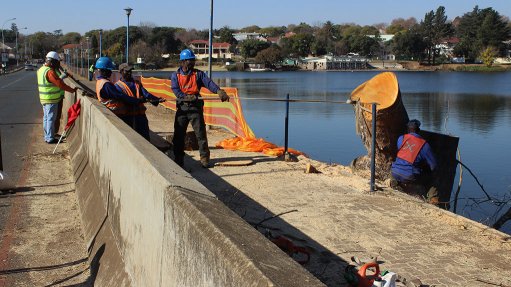
IMPROVED INFRASTRUCTURE Emmarentia dam’s infrastructure is currently being rehabilitated
The Johannesburg Roads Agency (JRA) in April embarked on a R25-million eight-month-long rehabilitation project for the City of Johannesburg’s (CoJ’s) 103-year-old Emmarentia dam.
The dam is located on the Westdene spruit, which is a tributary of the Jukskei river and a popular recreational venue for Johannesburg residents.
The dam’s ageing infrastructure, as well as erosion, corrosion and several significant floods, have necessitated the rehabilitation project, says JRA acting MD Mpho Kau.
“While significant improvements to Emmarentia dam were undertaken in 1988, a recent comprehensive investigation conducted by the JRA showed that preventative maintenance and flood-retention protection is required to safeguard the dam’s integrity and ensure the safety of residential properties downstream.”
Kau says the investigation revealed some subsiding, which means that the dam wall slope stability is potentially at risk. It also revealed that urgent repairs on the return channel are required as a major flood could undermine the existing gabion and concrete walls, which could cause significant structural damage.
Further, continued erosion could expose the banks and possibly undermine existing municipal roads located next to the return channel.
Kau adds that Olifants road, along the crest of the dam’s embankment, has also been affected by possible leaks within stormwater inlet structures, requiring repairs and road reconstruction.
The rehabilitation project is being undertaken in accordance with the CoJ’s stormwater by-laws and dam safety regulations, considering that the dam is classified as medium sized with a Category 3 high hazard potential rating.
Project Scope
Improving Emmarentia dam’s flood-prevention facility to protect properties located downstream of the dam from flooding will include excavating and repairing the pipework and surrounding soil at the stormwater structures located along the dam.
The project scope also includes altering outlet structures, repairing the box culvert outlet, widening the control section and constructing a gabion wall on the eastern side of the outlet. Further, the JRA will repair the dam wall by strengthening the stone-protection layer and addressing the obstructions currently located upstream of the culvert spillway, which decrease the capacity of the dam. These obstructions include the removal of the canoe storage shed located in the immediate vicinity of the spillway inlet, as this poses a serious risk in terms of public safety.
The trees located on the side of the left bank will also be removed, as well as a large plane tree on the upstream embankment, which is likely to grow significantly in size and could potentially become detrimental to the integrity of the embankment.
The JRA will also implement protection measures to prevent future erosion caused by high volumes of flooding water, which involves reconstructing and/or repairing the gabion wall and reconstructing the bottom of the channel.
A concrete wall will also be constructed where the channel comes close to the roadway to prevent damage to the roadway. Olifants road will also be reconstructed.
“We look forward to the completion of these preventative measures, which will ensure that the dam has the capacity to convey a flooding event of the 25-year recurrence flood peak value. We request the community’s cooperation while work is under way, as all rehabilitation will be undertaken without draining the dam,” says Kau.
The expected completion date of the rehabilitation project is January 2016.